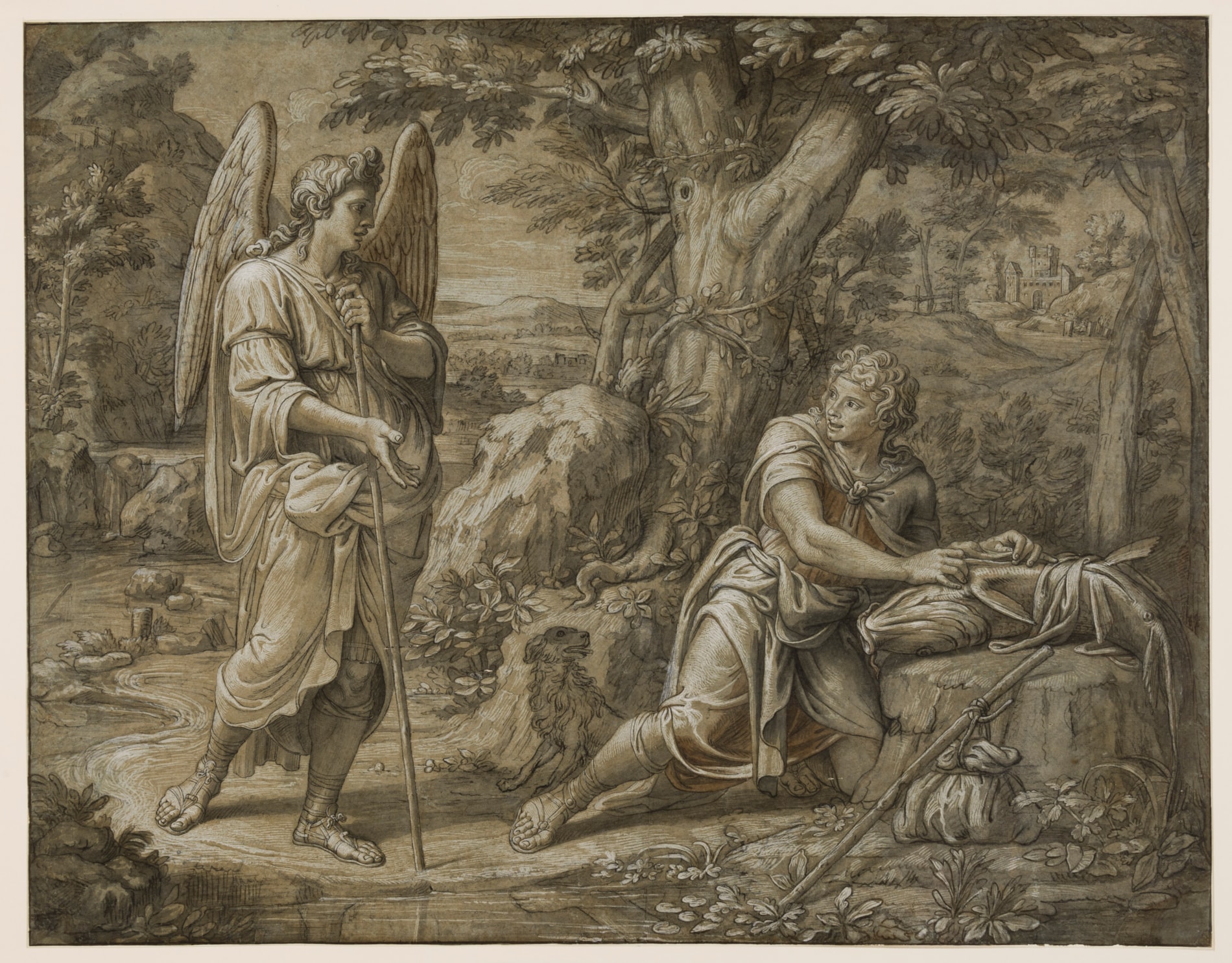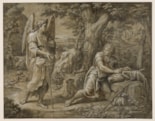Louis CHERON
(Paris 1660 - London 1725)
Tobias and the Angel
Sold
Pen and brown ink and two shades of brown wash, extensively heightened with white, over an underdrawing in black chalk, on blue paper, backed.
Framing lines in brown ink.
458 x 584 mm. (18 x 23 in.)
Framing lines in brown ink.
458 x 584 mm. (18 x 23 in.)
Louis Chéron’s drawings were highly esteemed by his contemporaries. His bold draughtsmanship, rooted in the French academic style, was to prove influential on the younger English artists that he met and taught in London. As the English antiquary and writer George Vertue noted of Chéron, his work was ‘much immitated by the Young people. & indeed on that account by all other lovers of Art much esteem’d & from thence rais’d his reputation.’ Hundreds of the artist’s drawings were dispersed in two auctions of the contents of his studio after his death, and the sale catalogues divide these into five categories; academic studies, copies after Renaissance masters, drawings in black chalk and grey wash, designs for book illustrations in pen and ink wash, and highly finished studies in pen, ink and gouache, of which the present sheet is a fine example.
A significant number of Chéron’s drawings were purchased at the posthumous sales of his studio by the 10th Earl of Derby, who came to own a large group of them. All but twenty of these are today in the British Museum, which holds the largest extant group of drawings by the artist, amounting to some 125 sheets. Other drawings by Chéron are today in the collections of the Harvard University Art Museums in Cambridge, Massachusetts, the Musée Fabre in Montpellier, the Ecole des Beaux-Arts and the Louvre in Paris, the Musée des Beaux-Arts in Rennes, the Nationalmuseum in Stockholm, and in several private collections.
One of Chéron’s finest drawings, this large sheet may be counted among a group of ‘extremely accomplished finished composition sheets or modelli [that] are the most plentiful type of drawing found in his extant oeuvre.’ As Alvin Clark has noted of such drawings, ‘In all of these sheets on dark tan or blue paper, Chéron uses strong but fluid and rhythmic contours in pen and ink that are amply supplemented with two tones of brown wash and generously heightened with white gouache…The lucidity of these finished studies is indebted to artists like [Charles] Le Brun and those in his circle at the French academies in Paris and Rome, but Chéron’s refinement and color also look forward to such eighteenth-century artists as François Le Moyne and Charles-Antoine Coypel. These are the kinds of drawings that engendered such high praise from Dezallier d’Argenville, who claimed that Chéron had a facility of invention and a level of taste rarely seen among his contemporaries.’
While the present sheet cannot be related to any surviving painting by the artist, it may be noted that the catalogue of the first of two posthumous auctions of Chéron’s estate in 1726 lists three paintings of this subject.
A significant number of Chéron’s drawings were purchased at the posthumous sales of his studio by the 10th Earl of Derby, who came to own a large group of them. All but twenty of these are today in the British Museum, which holds the largest extant group of drawings by the artist, amounting to some 125 sheets. Other drawings by Chéron are today in the collections of the Harvard University Art Museums in Cambridge, Massachusetts, the Musée Fabre in Montpellier, the Ecole des Beaux-Arts and the Louvre in Paris, the Musée des Beaux-Arts in Rennes, the Nationalmuseum in Stockholm, and in several private collections.
One of Chéron’s finest drawings, this large sheet may be counted among a group of ‘extremely accomplished finished composition sheets or modelli [that] are the most plentiful type of drawing found in his extant oeuvre.’ As Alvin Clark has noted of such drawings, ‘In all of these sheets on dark tan or blue paper, Chéron uses strong but fluid and rhythmic contours in pen and ink that are amply supplemented with two tones of brown wash and generously heightened with white gouache…The lucidity of these finished studies is indebted to artists like [Charles] Le Brun and those in his circle at the French academies in Paris and Rome, but Chéron’s refinement and color also look forward to such eighteenth-century artists as François Le Moyne and Charles-Antoine Coypel. These are the kinds of drawings that engendered such high praise from Dezallier d’Argenville, who claimed that Chéron had a facility of invention and a level of taste rarely seen among his contemporaries.’
While the present sheet cannot be related to any surviving painting by the artist, it may be noted that the catalogue of the first of two posthumous auctions of Chéron’s estate in 1726 lists three paintings of this subject.
Born into a Protestant Huguenot family of artists in France, Louis Chéron studied with his father, the enamel painter, miniaturist and engraver Henri Chéron, before entering the Académie Royale de Peinture et de Sculpture. A student of Charles Le Brun, Chéron won the Prix de Rome twice, in 1676 and 1678, and spent several years at the newly-established Académie de France in Rome. In Rome, he was particularly inspired by the work of Raphael; so much so that he often referred to himself, in later years, as a pupil of Raphael, according to the 18th century collector, connoisseur and biographer Antoine-Joseph Dezallier d’Argenville. In 1680, Chéron won a first prize at the Accademia di San Luca in Rome with a finished drawing of The Judgement of Solomon. After spending some time in Venice, where he painted a work for the church of San Pantaleone, Chéron returned to France in 1686. There he enjoyed some immediate success, painting two large votive ‘May’ pictures for the cathedral of Notre-Dame in Paris in 1687 and 1690. He also received a commission for paintings to decorate the salon of the townhouse of his sister, the well-known poet and painter Elisabeth-Sophie Chéron Le Hay, and provided etched illustrations for her Les Psaumes nouvellement mis en vers, published in 1693.
By the early 1690s, however, Chéron had settled in London, escaping the persecution of Protestants that followed the revocation of the Edict of Nantes by Louis XIV in 1685. He may have been encouraged to emigrate to England by one of his patrons, Ralph Montagu, 1st Earl and later 1st Duke of Montagu, who had been the British ambassador to France and was a leading patron of Huguenot artists. By 1693 Chéron was listed as a worshipper in the French Huguenot congregation in the Savoy Chapel in London, and in 1710 he became a British citizen, living and working in Covent Garden until the end of his life. Some of Chéron’s most significant English commissions were the result of Montagu patronage, notably for ceiling paintings at Boughton House in Northamptonshire and other works at Montagu House in London and Ditton Park in Buckinghamshire. He also produced decorative ceiling paintings for Burghley House in Lincolnshire and Chatsworth in Derbyshire.
In 1709 Chéron was one of five artists asked to submit designs for the decoration of the dome of St. Paul’s Cathedral; a commission eventually won by James Thornhill. He produced a significant number of cabinet pictures, and also worked extensively as a book illustrator, producing around 130 drawings for illustrations, mainly after 1710. In 1718 Chéron and John Vanderbank, who had both been teachers at Sir Godfrey Kneller’s Great Queen Street Academy, left to establish their own art school, the St. Martin’s Lane Academy. One of the first schools in Europe to employ female as well as male models, the Academy closed in 1724 when Vanderbank was forced to leave the country to avoid his debts. Chéron died the following year in London.
Provenance
Probably bequeathed by the artist, together with the rest of the contents of his studio, to Isaac Grassineau
Probably the Chéron studio sale, London, Covent Garden, 26 February-2 March 1726
Private collection, England
Anonymous sale, London, Phillips, 13 December 2000, lot 1 (as Circle of Julius Schnorr von Carolsfeld, sold for £21,850)
Emmanuel Moatti, Paris and New York, in 2001
Private collection.
Probably the Chéron studio sale, London, Covent Garden, 26 February-2 March 1726
Private collection, England
Anonymous sale, London, Phillips, 13 December 2000, lot 1 (as Circle of Julius Schnorr von Carolsfeld, sold for £21,850)
Emmanuel Moatti, Paris and New York, in 2001
Private collection.
Exhibition
New York, Emmanuel Moatti, Master Drawings 1600-1900, 2001, no.6.




